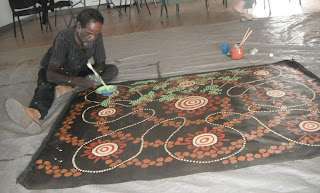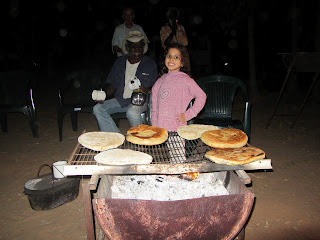It's rather poetic when your “shopping”
becomes “cargo”. Visions of the “cargo cult” of the Pacific
Islands spring to mind. After two days of wandering the supermarkets
in town with food prices that would make your eyes water ($10 for a
box of Corn Flakes!!!), we finally set off for the island.
Usually the family has their own speed
boat, but it has sprung a leak, so we made our journey on the local
banana boat. After wending our way on a potholed road through the
jungle for about an hour, we came to the “port” consisting of a
bunch of people sitting on the roots of huge trees on the waters edge
and three or four banana boats (a little bigger than a dingy and made
of fibre glass) ties to the roots. My suitcase and some other small
cargo was loaded onto a shipping palette at the center of the boat.
The family, three other passengers and the two boatsmen scrambled on
and I got pride of place at the front of the boat, sitting on the
pallet. The volcanic island loomed in front of us and after a butt
bruising hour on rough seas, we scrambled ashore on the black sand
beach.
There is one, semi-paved road running
around the outside of the island. We drove to the plantation through
countless tiny villages made up of grass huts and the occasional
market. It makes sense to build houses out of grass since the
rainfall is around 2,500mm a year. Everything rots, so you might as
well make your house out of something you can rebuild and repair
without great expense.
The plantations that surround the
island are made up of massively tall coconut trees with cocoa
cultivated underneath. As we drove along the coast with the kids and
the cargo in the back of the pick-up truck, everyone we passed waved
and smiled. A bunch of kids playing soccer. Women with naked babies
on their backs. Men carrying bamboo and bales on their heads.
People outside huts cooking over open fires. Coconut trees and jungle
everywhere.
We finally got to the plantation just
as it was starting to get dark and I finally saw my new home. The
teachers house/school house is brand new. I'm the first person to
live in it. It's a three bedroom bungalow with a huge veranda
overlooking the coastal cliffs. It has been built to catch the
breezes with louvered and screened windows. The trees on the cliff
in front of my house are full of bananas and papayas (but I'm not
sure how to get them without falling down the cliff). The view is
spectacular.
The kids gave me a tour of the garden
the next day. I returned with an armful of fruit from the trees.
There is a patch of pineapple, a patch of watermelon, starfruit,
passionfruit, a lime tree, not to mention the ubiquitous coconuts,
bananas, papayas and sweet potatoes. There is a set of stairs that
leads down to a beautiful, shaded, black sand beach with translucent
water and coral just off shore.
We also went to see the copra
processing plant and the storerooms where the copra is dried. The
family runs a supplies store nearby where you can get staples like
flour, sugar, rice, tinned tuna and coca cola. Because there is so
much theft, the store is behind a barricade. You have to walk up to
the counter and ask for what you want. You can't wander the shop and
take things off the shelf. I was introduced to everyone there so
they would know I belonged to the plantation and wasn't just some
lost white woman.
The local brand of tinned tuna is
called “Diana”. I think it's hilarious. It feels like I've
fallen victim to a very sophisticated new type of cannibal with their
own processing plant. Strangely the locals don't go out and catch
their own tuna (which is abundant in these waters). They all eat
tinned tuna.





